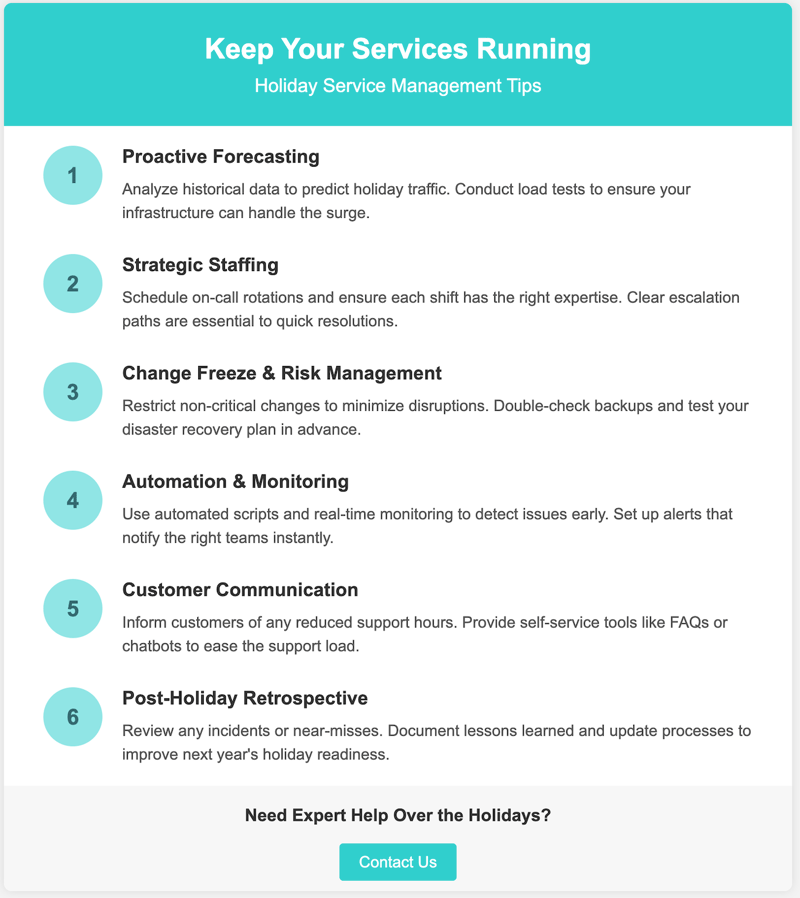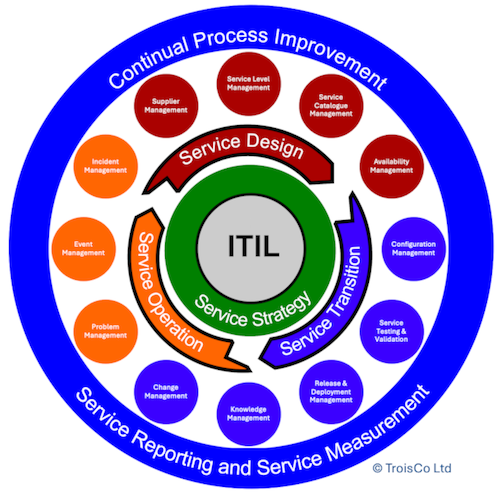Considerations for End-of-Year Holiday Service Management

Ensuring smooth service management during the end-of-year holiday season when resources are limited requires careful planning and proactive measures.
- Proactive Capacity & Demand Forecasting
- Demand Analysis: Thoroughly review historical data to identify demand peaks during holidays. Pinpoint the hours or days when traffic typically surges.
- Load Testing: Conduct load tests on critical systems to confirm they can handle the predicted traffic levels.
- Scalable Infrastructure: Consider temporary or dynamic scaling through cloud services (e.g., auto-scaling groups, container orchestration) to manage sudden usage spikes.
- Considerately Planned Staffing & Scheduling
- Staffing Matrix: Create a staffing matrix detailing who is available, what their skill sets are, and how they may be rotated or paired.
- On-Call Support: Clearly define on-call duties, including primary and secondary contacts. Ensure all relevant staff know how to escalate critical issues.
- Holiday Coverage: If staffing is critically low, negotiate external support or cross-train employees beforehand.
- To The Point Communication & Transparency
- Internal Updates: Set up regular stand-ups or status updates to keep everyone informed about shifts, escalations, and any potential risks.
- Customer Notifications: Notify customers through email, social media, or support portals about reduced support availability and where to find self-service resources.
- Verified Automation & Monitoring
- Automated Workflows: Use scripts or configuration management tools (Ansible, Chef, Puppet) to reduce manual intervention in deployments or routine maintenance.
- Real-time Monitoring: Establish 24/7 monitoring for critical KPIs (response times, error rates, system health) with clear, automated alerting.
- Machine Learning Insights: Where possible, leverage predictive analytics to detect anomalies before they become critical incidents.
- Predictive Risk Mitigation & Disaster Recovery
- Change Freeze: Lock down non-essential changes or updates during peak holiday times to minimize unexpected downtime.
- Disaster Recovery (DR) Drills: Run a DR test or tabletop exercise in advance to verify backups, data integrity, and the failover process.
- Documentation: Keep your DR runbooks and incident response documentation easily accessible, ensuring anyone on-call can promptly follow the steps.
- Empower Customers with Self-Service
- Knowledge Base & FAQs: Provide easy-to-follow instructions for common troubleshooting steps or known issues.
- Automated Chatbots: Deploy chatbots for front-line support to handle basic queries and gather preliminary data, allowing on-call staff to focus on critical cases.
- Constructive Post-Holiday Review & Lessons Learned
- Incident Retrospectives: Conduct a comprehensive review to identify what went well and what needs improvement, capturing insights for future holiday seasons.
- Service Optimization: Use these insights to enhance processes, update documentation, and possibly invest in tools that will lighten the load next time around.
- Enjoy The Holidays
- Trust the system: After carefully planned and implemented processes are in place, trust the processes and trained professionals to take care of Service and focus on time off work.
- Remember to wind down: Taking and using the time on Holidays for recharging will energise you to meet the oncoming challenges as the year starts again after the holidays.
#ServiceManagement #HolidaySeason #ITOperations #CustomerExperience #TechLeadership
 By
By


